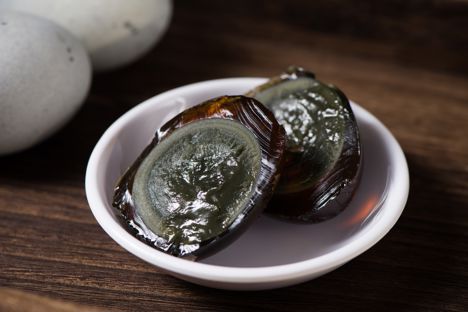
Ash and clay: a taste of China’s century eggs
Pungent, complex and umami-packed, pidan, or century eggs, are a delicacy in China, Hong Kong and parts of Southeast Asia. We take a closer look at how they're made and how to eat them.
Ash and clay: a taste of China’s century eggs
Pungent, complex and umami-packed, pidan, or century eggs, are a delicacy in China, Hong Kong and parts of Southeast Asia. We take a closer look at how they're made and how to eat them.
Pidan, 100-year eggs, 1,000-year eggs, millennium eggs or alkalised eggs – whichever moniker they go by, you may well have already heard of China's dark-hued, preserved century eggs. Known for their distinctive smell and rich, earthy flavour, they are spotted less often in western cuisines, but are a delicacy across many parts of Asia, where they're eaten on their own, as a side dish or used to enhance dishes' flavour. Whether you're new to century eggs or just fancy jogging your memory, we've taken a look at the basics below.
What is a century egg – and are they actually 100 years old?
Though their names would suggest otherwise, the eggs – which are usually duck, chicken or quail – are preserved in a paste (more on that below) for weeks or months, rather than years (it's probably closer to 100 days). That process raises the pH of the eggs and stops them from spoiling, while transforming their texture, colour and flavour, resulting in the dark yet translucent white and custard-like yolk.
How are century eggs made?
Eggs are covered in an alkaline paste of wood ash, salt, clay, quicklime and tea, coated in rice husk and put away in a sealed container. Then they are left for weeks or months; that chemical reaction causes the egg white to darken in colour, to anything from an amber to deep black hue, with the yolk ending up with rings of soft green and yellow. Texturally, the white becomes gelatinous (similar to firm tofu), while the yolk turns gooey and creamy. Century eggs can be found in plenty of Asian supermarkets, though you can make them at home if you stock up on the ingredients – just make sure to do your research first.
What do century eggs smell and taste like?
For those new to century eggs, it's often the smell that can be the biggest challenge; they tend to have a slight aroma of ammonia and sulfur, thanks to the egg proteins breaking down during the preservation process and the increased pH (it should only be mild – an overwhelming ammonia odour can be a sign that something has gone wrong). The taste is less overpowering; century eggs' flavour is often described as umami, salty, pungent and very savoury, with complex notes not dissimilar to blue cheese, though it varies depending on how long they have been cured.
How are century eggs eaten and how do I cook them?
Century eggs are most commonly eaten as they are and usually not cooked. Though you can bite straight into them, their strong flavour means they're more often broken up and used as a seasoning or condiment. They're also sliced and put on top of rice, enjoyed with soy sauce as an appetiser, or added to congee (a Chinese rice porridge). In Cantonese cuisine, century eggs are wrapped and eaten with slices of pickled ginger, while in Taiwan it's popular to put them on top of cold tofu with katsuobushi, soy sauce and sesame oil. Sometimes chopped century eggs are combined with fresh eggs in an omelette, while at special occasions the Cantonese lahng-poon, a platter of barbecue pork, pickled baby leeks, carrots, radish and quartered century eggs, is the centrepiece. Around the world, chefs have weaved them into salads, stir fries, sushi rolls and even pasta.
Are century eggs safe?
If made properly, century eggs are completely safe. There was once a rumour that century eggs were made by soaking them in horse urine, but that's not true. If you buy your century eggs from a shop, check the label to make sure they weren't made with lead oxide – eating foods with lead oxide can be harmful. Because the ingredient sped up the process, it was at one used by some producers, but has thankfully become much less common today.
What is the history of century eggs?
Though it's hard to pin it down exactly, we know century eggs originated in ancient China and initially proved popular as a means of preserving eggs to make sure they were readily available. It's believed they first came into being during the Ming Dynasty – from 1368 to 1644 – but after becoming popular in China, they soon spread further afield in Asia and today are also widely made in Hong Kong and Taiwan. Some stories say their invention was accidental; one says that a man in Hunan found preserved duck eggs in the slaked lime clay used to build his house, while another puts it down to a man leaving duck eggs outside to impress a woman he wanted to date; when they were found months later, they had fermented.


